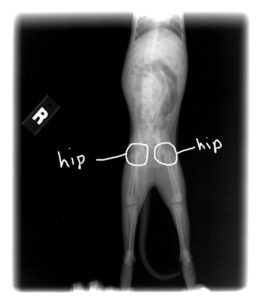Hip Dysplasia and Persian Cats
Hip dysplasia is not as prevalent in cats as it is in dogs. Occurrences of hip dysplasia in cats are pretty rare. As a former German Shepherd Dog breeder I am well aware of this painful disorder. In almost 20 years of raising and showing German Shepherd dogs I had less than four incidences of hip or elbow dysplasia. Hip dysplasia is genetic as are all things when you discuss breeding (humans, animal, etc.). However, the inheritance of hip dysplasia found in dogs is quite different than in cats.
Additionally, there are environmental and nutritional factors that can tip the scales on an animal who is borderline for dysplasia (i.e., obesity is a huge factor). We know from the careful breeding of only those dogs without hip dysplasia produced fewer incidences of the disorder in their offspring. However, it is a bit more complicated in cats. The authorities and researchers are not sure of how it is “inherited” in cats so their suggestion is not to breed a dysplastic cat. I agree with that thought as far as breeding dysplastic cats. However, just because a certain breeding pair without dysplasia that may have produced one kitten with hip dysplasia does not mean that breeding pair should be removed from a breeding program unless it happens more than once.
What is Hip Dysplasia?

Cat with Hip Dysplasia
Hip Dysplasia (after the Greek word for “malformation”) is the malformation of the ball-and-socket joint that connects the cat’s femur (thigh bone) to its hip (socket or cup).
In cases of dysplasia, the “ball” is the knobby top end (femoral head) of the thigh bone and the “socket” is a cup-shaped cavity located at the lower end of the hip bone.
In normal hips the femoral head fits snugly within the “socket” freely gliding and partially rotating to allow a cat to lie down, stand up, climb, chase, etc.
What do the Experts Say?
An article by Cornell University:
"A specific cause of feline hip dysplasia has not been identified, although the condition is widely thought to have a genetic component, since it seems to be more prevalent in certain breeds, such as Maine Coons. Other factors appear to play a causative role in the development of the disability; it is believed, for example, that obesity significantly increases the pressure on the hip’s supporting structures and may, therefore, contribute to excessive wear and tear on the joint. For now, however, veterinarians generally agree that the only way to prevent hip dysplasia would be to avoid the breeding of cats that are thought to be genetically predisposed to the condition."
Research has shown that hip dysplasia occurs more often in the Maine Coon breed; an estimated 20% are affected.
Colleen Power, in her article "Hip Dysplasia in Cats" in the June 1992 issue of Persian News, says,
"There is no single gene that is responsible for hip dysplasia. Instead there is a gradual piling up of genetic factors... . The process is so dangerously gradual that, until the severe limp appears, the breeders' will have no idea that they have been gradually altering the skeleton and musculature with each generation."
How is Hip Dysplasia Diagnosed?
Hip Dysplasia is best diagnosed through radiography (x-rays) of the pelvic region, a procedure that requires the cat to be under anesthesia. The Hip Dysplasia Registry of the Orthopedic Foundation for Animals (OFFA) at the University of Missouri, assigns nine variations of congruity and fit between the femoral head (top of the thigh bone) and the acetabulum (hollow area in the pelvic bone into which the thigh bone fits):
- Excellent
- Normal, for age and breed
- Less than ideal, but within normal limits
- Near normal, minor hip joint abnormalities
- Borderline minimal dysplastic change
- Grade 1 dysplasia, subluxated (partially dislocated) 25 percent
- Grade 2 dysplasia, subluxated 50 percent
- Grade 3 dysplasia, subluxated 75 percent
- Grade 4 dysplasia, femoral head luxated (dislocated) out of acetabulum
Only cats with hips rated 1 through 3 should be used for breeding.
Treatment Options
Pelaqita's Dysplasia History

x-ray of Faith's kitten malformed hip joints
The summer of 2018, Faith and Mikey had a litter of six female kittens. At about ten weeks of age, I noticed that one of the girls was limping on her right hind leg. I figured she had pulled something playing and I kept an eye on her for the next few days to see if it would improve. It did not improve, so I took her to the veterinarian. X-rays were taken, and the results were that the kitten had hip dysplasia. We have found an excellent home for this special kitten with a former client who is also a working vet technician.
It has happened one other time to Ellison (not the same breeding as above). Read Ellison's story as written by his parents.
For further reading, Hip Dysplasia by Cornell University.
